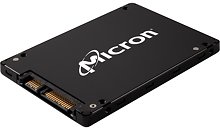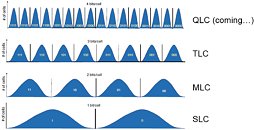Raevenlord
News Editor
- Joined
- Aug 12, 2016
- Messages
- 3,755 (1.20/day)
- Location
- Portugal
| System Name | The Ryzening |
|---|---|
| Processor | AMD Ryzen 9 5900X |
| Motherboard | MSI X570 MAG TOMAHAWK |
| Cooling | Lian Li Galahad 360mm AIO |
| Memory | 32 GB G.Skill Trident Z F4-3733 (4x 8 GB) |
| Video Card(s) | Gigabyte RTX 3070 Ti |
| Storage | Boot: Transcend MTE220S 2TB, Kintson A2000 1TB, Seagate Firewolf Pro 14 TB |
| Display(s) | Acer Nitro VG270UP (1440p 144 Hz IPS) |
| Case | Lian Li O11DX Dynamic White |
| Audio Device(s) | iFi Audio Zen DAC |
| Power Supply | Seasonic Focus+ 750 W |
| Mouse | Cooler Master Masterkeys Lite L |
| Keyboard | Cooler Master Masterkeys Lite L |
| Software | Windows 10 x64 |
Micron has announced that they will be introducing QLC (Quad Level Cell) NAND-based, own brand drives for the server environment this year. The new QLC drives are expected to boost maximum storage density (and price per GB) closer to that of mechanical HDDs, which is why Micron is positioning drives based on this memory technology as data center-class SSDs for the nearline storage market. The company is positioning these drives as replacement options for 7,200 RPM HDDs for workloads that require heavy reads of stored information - thus offsetting QLC NAND's lower endurance when it comes to available maximum writes on the drives' cells.
It's a known trade-off when it comes to the NAND world: higher amounts of bits per cell to represent information means that there must be much increased accuracy when it comes to reading a given cell's voltage state. While SLC NAND only tracks two voltage states, MLC (2-bits per cell) tracks four voltage states, TLC doubles that to eight voltage states, and QLC doubles the ante again for a maximum 16 voltage states, where each voltage state represents data on the cell. Of course, with repeat writes and voltage changes, accuracy and capacity for the cell to maintain its given voltage tend to drop, which leads to incorrect information and thus corrupted data or those cells to be rendered inoperative. This is one of the reasons for manufacturers to include overprovisioning in their NAND-based solutions.


That means these drives are much better suited for WORM workloads (Write Once, Read Many). The drive will be positioned below the existing 5200-series SSDs, and carry features aimed at hyperscale data centers.Perhaps Micron has developed a built-in resilience in its NAND chips to the deterioration that's expected from QLC drives, or maybe they've found a way to best or equal Toshiba, who announced last year that it had managed to increase endurance of its 3D QLC NAND flash to 1000 program/erase cycles by using a stronger ECC mechanism.


The first batch of Micron-branded, QLC-based SSDs will have a SATA interface, though Micron said it is planning to release NVMe models. These will hit the enterprise markets first - where Micron has an easier task of recouping their investment due to higher revenue, while simultaneously allowing the company to take some more time to increase yields before adding the consumer demand strain to the equation. However, users should expect QLC-based drives to become real alternatives not too long after.
View at TechPowerUp Main Site
It's a known trade-off when it comes to the NAND world: higher amounts of bits per cell to represent information means that there must be much increased accuracy when it comes to reading a given cell's voltage state. While SLC NAND only tracks two voltage states, MLC (2-bits per cell) tracks four voltage states, TLC doubles that to eight voltage states, and QLC doubles the ante again for a maximum 16 voltage states, where each voltage state represents data on the cell. Of course, with repeat writes and voltage changes, accuracy and capacity for the cell to maintain its given voltage tend to drop, which leads to incorrect information and thus corrupted data or those cells to be rendered inoperative. This is one of the reasons for manufacturers to include overprovisioning in their NAND-based solutions.


That means these drives are much better suited for WORM workloads (Write Once, Read Many). The drive will be positioned below the existing 5200-series SSDs, and carry features aimed at hyperscale data centers.Perhaps Micron has developed a built-in resilience in its NAND chips to the deterioration that's expected from QLC drives, or maybe they've found a way to best or equal Toshiba, who announced last year that it had managed to increase endurance of its 3D QLC NAND flash to 1000 program/erase cycles by using a stronger ECC mechanism.


The first batch of Micron-branded, QLC-based SSDs will have a SATA interface, though Micron said it is planning to release NVMe models. These will hit the enterprise markets first - where Micron has an easier task of recouping their investment due to higher revenue, while simultaneously allowing the company to take some more time to increase yields before adding the consumer demand strain to the equation. However, users should expect QLC-based drives to become real alternatives not too long after.
View at TechPowerUp Main Site


